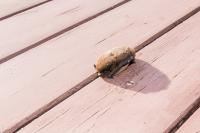
Bats are a common sight across the village at dusk and we appear to have many successful colonies in the parish.
During August last year, a dead bat was found just off the Whittington Woodland and was identified as a Brown Long Eared Bat. Until this point, no-one in the village was aware we had Brown Long Eared bats in the village.
Local bat enthusiasts Lisa and Thomas Mason arranged a bat walk using their bat detector around the woodland at dusk on 14th August. The detector identified that we have three species of bat living in and around the Whittington Woodland.
The species identified were Daubenton’s, Common Pipistrelle and Brown Long Eared bat.
Each bat has its own frequency and sound pattern. The bat detector speakers played the sonar sounds to the group as we walked around, and it was a truly wonderful experience to hear them.
Common Pipistrelle - This is the commonest British bat. It weighs 5 grams (same as 20p piece) and can eat 3,000 insects in one night. They are 4cm long and have a wingspan of just over 20cm. The colony size is between 30-70 and they usually live for 4-5 years, but can live up to 11 years
Daubenton’s bat – known as the water bat as they fish insects from the water’s surface with their large feet or tail. They weigh 7-12 grams and like to eat midges, caddisflies and mayflies. They are 5cm long and have a wingspan of 24-27 cm. The colony size is between 20-50 and they can live up to 22 years.
Brown Long Eared bat – its huge ears provide exceptionally sensitive hearing – it can even hear a ladybird walking on a leaf. They weigh 6-12 grams and eat moths, beetles, flies, earwigs and spiders. They are 4-5cm long and have a wingspan of 23-28cm. The colony size is between 10-30 and they can live up to 30 years
It would be great to find out where we have bats and what types we have in the village. We decided to make a grant application to the Veolia Envirogrant fund for monies to buy a professional Bat Detector that plugs into an iPhone or iPad, as well as to buy some new bat boxes and conservation units. The grant was awarded, and we will be purchasing the equipment shortly.
We are very keen that the bat detector is widely used, and we will train up some WFEG volunteers to run bat walks for villagers where they can do some bat detection themselves.
The detector itself is very simple to use and we can also loan out to groups wanting to make use of it.
We particularly hope that the youth groups will partake to raise awareness of bats with our younger people.